#tanana river
Text

Little Delta Junction - August 2023
I took this image of the junction between the Little Delta River and the Tanana River at a pull out as we traveled from Fairbanks, Alaska, to Tok. The complex meandering of both rivers makes for an interesting image.
MWM
0 notes
Text

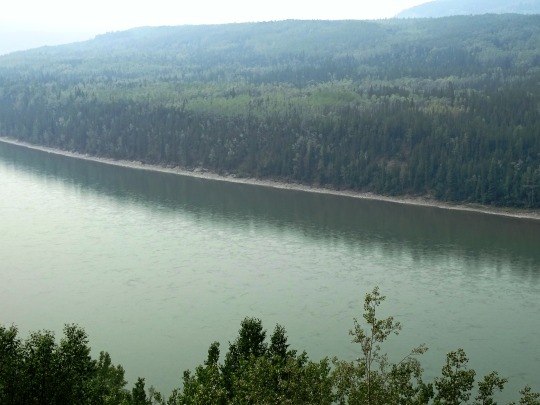
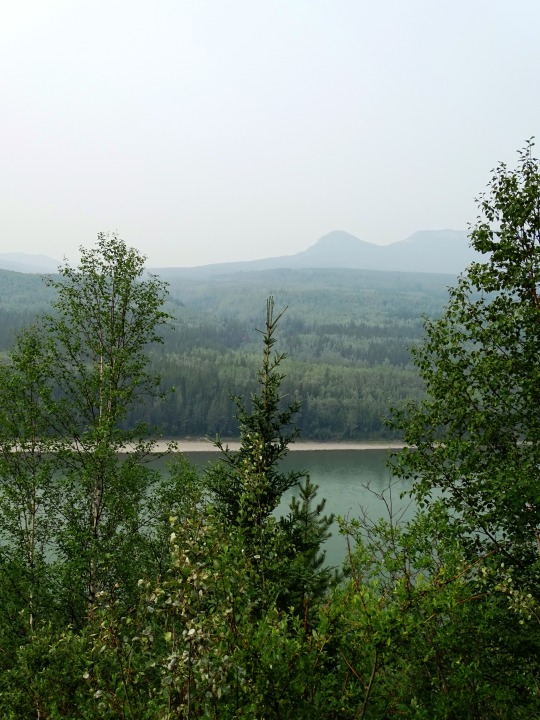


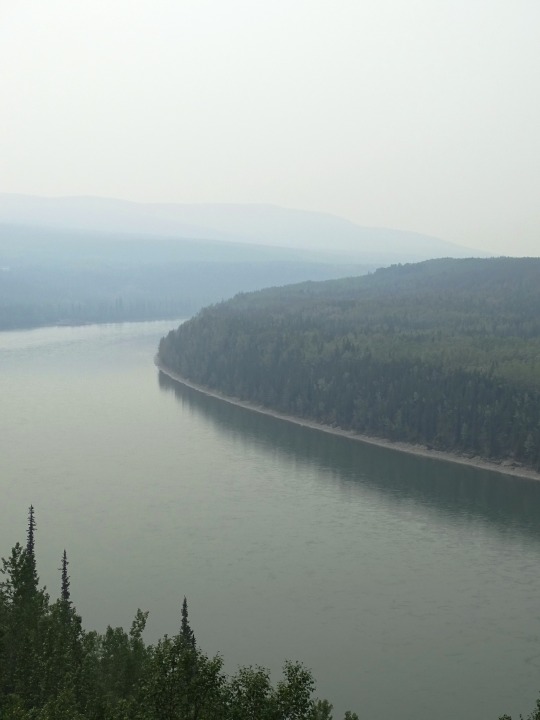




Allen's Lookout, BC (No. 1)
The Liard River of the North American boreal forest flows through Yukon, British Columbia and the Northwest Territories, Canada. Rising in the Saint Cyr Range of the Pelly Mountains in southeastern Yukon, it flows 1,115 km (693 mi) southeast through British Columbia, marking the northern end of the Rocky Mountains and then curving northeast back into Yukon and Northwest Territories, draining into the Mackenzie River at Fort Simpson, Northwest Territories. The river drains approximately 277,100 km2 (107,000 sq mi) of boreal forest and muskeg.
The river habitats are a subsection of the Lower Mackenzie Freshwater Ecoregion. The area around the river in Yukon is called the Liard River Valley, and the Alaska Highway follows the river for part of its route. This surrounding area is also referred to as the Liard Plain, and is a physiographic section of the larger Yukon–Tanana Uplands province, which in turn is part of the larger Intermontane Plateaus physiographic division.
The Liard River is a crossing area for Nahanni wood bison.
Source: Wikipedia
#Allen's Lookout#BC#Liard River#travel#original photography#vacation#tourist attraction#landmark#landscape#countryside#British Columbia#woods#forest#nature#flora#tree#river bank#wildfire smoke#summer 2023#Canada#view#vista point#boreal forest#Northern Rockies#Rocky Mountains
22 notes
·
View notes
Photo
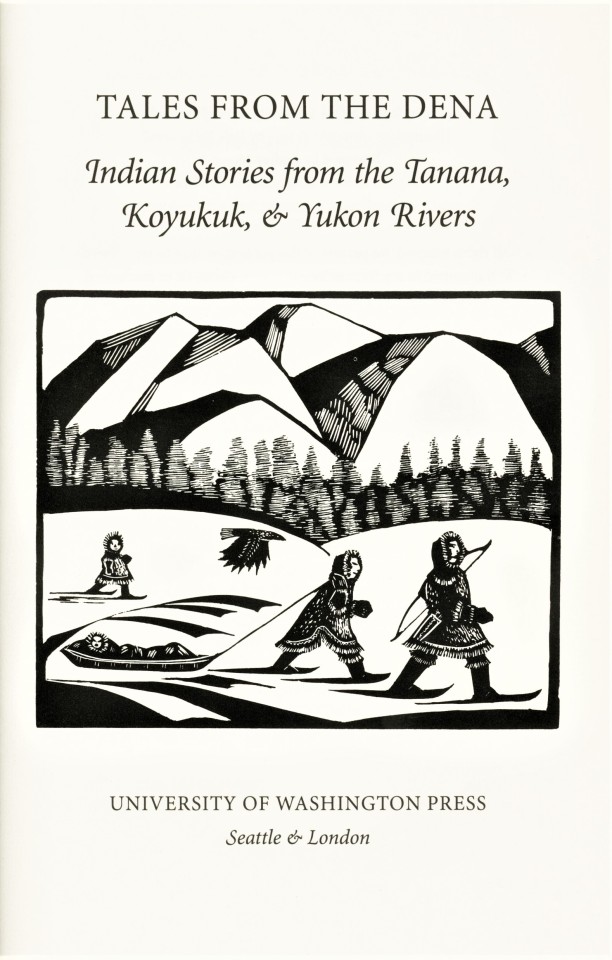









Wood Engraving Wednesday
DALE DEARMOND
Alaskan artist, librarian, and wood engraver Dale DeArmond (1914-2006) illustrated indigenous Alaskan stories and folktales for over half a century. In an interview she observed, "I'm an illustrator. And I prefer to illustrate myths and legends. Mostly myths and legends of the Native Alaskan people, and other things that relate to Alaska because I've been up here so long, that's all I know about…” DeArmond was born in North Dakota, educated in Tacoma, Washington, and then moved to Alaska after marrying Robert Neil DeArmond, a native of Sitka, where she remained for the rest of her life.
DeArmond began her artistic career as a painter, but in 1959 she trained with painter and woodcut artist Danny Pierce, a long-time Art professor here at UW-Milwaukee who spent much time in Alaska, and her career was transformed as a woodcut artist. She spoke about this experience in several interviews:
A friend and I spent the whole day watching Danny do a woodcut and print it. We could hardly wait until the next day to go to the builder's supply and get the materials. . . . Danny Pierce's demonstration made everything seem so simple. . . . The joyful thing about woodcuts is that even your first efforts look good. . . . I was a painter and illustrator in 1960 when I did my first woodcut and I have been having a love affair with wood ever since.
Then, after taking a wood engraving class in 1978, her career was transformed again, producing hundreds of wood-engraved prints and illustrations until the onset of dementia put an end to her career in 1999. By then, she had become a very notable figure in Alaskan cultural life. When asked about this notoriety, she responded, “Well, it's easy to be famous in Alaska!”
The work shown here, some of the last of DeArmond’s long career, are wood engravings for the 1995 publication Tales from the Dena, Indian Stories from the Tanana, Koyukuk, & Yukon Rivers, published by the University of Washington Press. The collection includes 41 Alaskan Indian tales, originally transcribed in 1935 by Frederica de Laguna and Norman Reynolds during an archaeological survey of the middle and lower Yukon River valley. de Laguna writes:
To my delight, Dale DeArmond, who has illustrated so many Alaskan stories, expressed an interest in illustrating these [stories]. . . . With this collaboration, I knew that we should offer this book to the general public . . . . Not least among those who I hope will find enjoyment in the book are the children and grandchildren of out storytellers, who told us the Tales from the Dena so long ago.
Dale DeArmond and I have asked that twenty percent of the royalties . . . go to the Doyon Foundation, a Native organization in Fairbanks, Alaska, to be used for the benefit of the Dena children and young people.
Click on the images to see the captions.
View more posts with wood engravings!
#Wood Engraving Wednesday#wood engravings#wood engravers#women wood engravers#Dale DeArmond#Danny Pierce#Tales from the Dena#Frederica de Laguna#Norman Reynolds#University of Washington Press#Denaʼina#Alaskan stories#indigenous Alaskans#Native Americans#Native American literature#illustrated books
142 notes
·
View notes
Photo

Spring brought impactful weather to portions of Alaska, including high water levels on most rivers and an ice jam on the Tanana River caused flooding & inundated Manley Hot Springs. Much of southern Alaska was unusually warm & dry in May.
by @IARC_Alaska
74 notes
·
View notes
Text
New Footage Shows Possible Explosion Before Cargo Plane Crashes In Fairbanks
Zero Hedge
By Tyler Durden – April 24, 2024
New footage has emerged on X of what appears to be a possible explosion moments before the Douglas C-54 Skymaster cargo plane crashed into the Tanana River near Fairbanks, Alaska, on Tuesday evening.
AP News said the Douglas C-54, a variant of the DC-4 airliner, crashed about 7 miles from Fairbanks International Airport.
Read more…

View On WordPress
0 notes
Text

A devastating incident in Alaska as a Douglas DC-4 aircraft operated by Alaska Air Fuel crashes into the Tanana River near Fairbanks.
Witnesses heard an explosion before the plane, carrying two, caught fire.
No survivors found. NTSB is investigating.
#AlaskaPlaneCrash #DC4 #Fairbanks
0 notes
Text
Through Anchorage
Day 20 -
We woke up on the side of the highway, it was 12c and almost raining. The accident scene from the night before was all cleared away and we were on our way into Anchorage to fill up with gas.


We did a tour of the town on a bus and did a walk through the Anchorage museum.


Back onto Hwy 1 east to Palmer and on up river to Glenallen. Rough and narrow road, many frost heaves, very little signage and impossible to drive the speed limit. There are many pullouts to take in the views of the Chugach mountains and the Mantanuska and Nelchina glaciers.

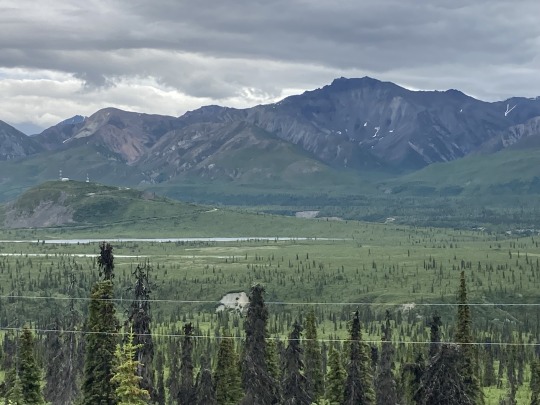
After Glenallen the weather started to improve, it got warmer as we followed the Copper river valley to Mentasta on the south slopes of the Alaska Range. The views became magnificent as we gained altitude at Chistochina but the road had undulations like a pump track in some sections, sometimes without warning.


We then drove through another pass across the mountains to the north slope of the Alaska Range, the road took us through a long side valley to the Tanana river and Tok for another overnight stay.
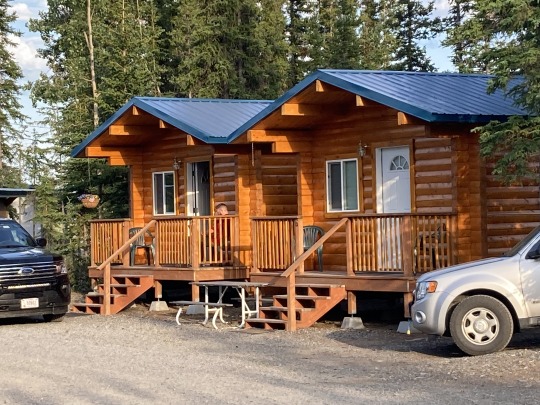

To our surprise the campgrounds were generally not very busy and I expected to see more traffic on the highways.
0 notes
Text
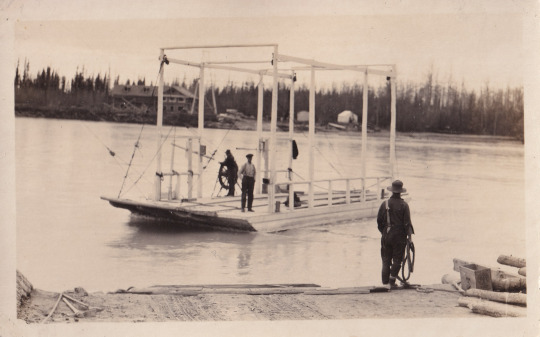
ferry raft on the tanana river, alaska. mccarty's roadhouse on the opposite bank.
rppc, ca. 1920s
1 note
·
View note
Text
Tanana Chiefs Conference Awarded $35 Million Grant To Bring Broadband To Rural Alaska Villages

Tanana Chiefs Conference (TCC) has secured a significant $35 million grant to bring high-speed broadband to underserved communities in Alaska. The project, which is part of the larger Alaska FiberOptic Project, aims to establish a 100% fiber-based network in three villages: Venetie, Chalkyitsik, and Circle.
The Alaska FiberOptic Project is a collaborative effort involving several key entities, including Calista Corporation, Doyon, Limited, Gana-A ‘Yoo Limited, Tanana Chiefs Conference, and Alaska Communications. This initiative intends to connect over 20 communities in Alaska's Yukon and Kuskokwim regions, starting from Fairbanks and extending all the way to the Bering Sea Coast. The network will begin in Fort Yukon and stretch to Venetie, with a submarine fiber cable to be laid in the Yukon River, connecting Fort Yukon and Circle. The result will be Gigabit-speed internet access for residents and businesses through fiber-to-the-home connections.
The lack of reliable connectivity has long been a barrier to progress in education, healthcare, economic opportunities, and overall well-being for Alaska's rural communities. Brian Ridley, Chief and Chairman of Tanana Chiefs Conference, emphasized the importance of addressing this digital divide and expressed gratitude for the grant. He highlighted the collaboration with Native Corporation partners, government entities, and Alaska Communications in working toward digital equity for Alaska Native Villages.
Read More - https://bit.ly/3Rwr638
0 notes
Text
Airstreaming to Alaska - Chapter 19: Tok to Haines
The scenery on our four-day, 686-mile journey toward Haines was agonizingly beautiful. So we sank our eyes deep into every dog leg turn, peek-a-boo glacier, and graceful river valley.
Posted July 9, 2023 – Narrated by Carmen
To listen to the podcast, click the play button
If we were young, we’d probably sugar-sprinkle our Alaska exit saying, “We’ll be back.”
Haines Highway north of Pleasant Camp
But as we pulled out of Chena Hot Springs we weren’t whipping up any comeback sauce.
Tanana River, Big Delta, Alaska
We knew the score.
There would be no reprise of our…

View On WordPress
#Airstream#Airstream Blog#Airstream Life#Airstream Travel Blogs#Airstreaming#Beaubeaux#beaver creek#destruction bay#Full-time Airstreaming#Full-time RV Living#Full-Time RVing#haines#Living in Beauty#living simply#Living the Dream#simple living
0 notes
Text

Mirror Image - August 2023
Because the Chena River is backed up and prevented from flowing by the Tanana River, the water is very calm and highly reflective. I took many images of cabins and homes reflected in the water, but I found this natural image the most impressive.
MWM
#alaska#fairbanks#riverboat#riverboat discovery iii#chena river#tanana river#mirror image#reflection on water
1 note
·
View note
Photo



A Tumultuous Spring Breakup The melting of winter snowpack and breakup of river ice caused damaging floods along the Yukon, Tanana, Kuskokwim, and other Alaskan rivers over several weeks in May 2023. Alaska’s governor declared a state of emergency on May 13 in response to the widespread impacts on riverside communities. These images reveal a rapidly transformed landscape along the upper Yukon River. The earlier image (top), acquired on May 6, 2023, by the Operational Land Imager (OLI) on the Landsat 8 satellite, shows a frozen stretch of the Yukon River near the town of Circle, Alaska, cutting through the snow-covered landscape. The other image (centre), acquired eight days later by the OLI-2 on Landsat 9, shows the land with almost no snow and the river flowing freer until approximately 25 miles (40 kilometers) downriver (northwest) of Circle, near the top of the image. In the intervening time, the town of Circle underwent dramatic flooding as broken-up ice pushed down the river. Flooding in town started at about 5 p.m. on May 13. “It was reported that the water rose 10 feet in a 30-minute period shortly after that,” said meteorologist Jim Brader of the National Weather Service (NWS) forecast office in Fairbanks. Ice jams—pieces of broken-up ice that obstruct the flow of a river—often contribute to flooding. The extent to which these jams were a factor in flooding in Circle is uncertain. NWS observers in the field did not find evidence of a single large ice stoppage. Instead, they speculated that flooding in the town could have been due to smaller jams, slower flow where the river becomes braided near Circle, and large amounts of water and debris released from ice jams upriver. The floodwaters seemed to recede about as quickly as they rose, according to media reports. A pilot observed that the airport tarmac was dry by 10 a.m. the next morning, on May 14. However, buildings and infrastructure in town sustained significant damage, with several homes being knocked off of their foundations. The lower photograph, from the NWS Alaska-Pacific River Forecast Center, shows an aerial view of Circle at 2:40 p.m. on May 14. “Although ice jams happen every year, this year was much worse than average,” said Brader. Flooding to this extent may occur every 10 to 20 years in some locations, he said, but preliminary data indicate that the flood at Circle was near the record level of 1945. Cooler-than-average temperatures in April followed by a delayed, rapid warm-up in May shoulder much of the blame. An above-average winter snowpack also contributed to the floods’ severity. Temperatures rose while much of the snow and ice was intact, setting off what is known as a dynamic breakup. In this scenario, river ice breaks into large chunks that are more likely to jam up as they move down the river. Runoff from snowmelt adds more water into the system, exacerbating floods. In contrast, a more gradual warm-up results in a thermal breakup, in which ice slowly rots in place and resists forming jams. The spring breakup caused more flooding along the Yukon River in late May as broken river ice proceeded downstream in fits and starts. The National Weather Service continued to track the location of ice jams and floods. NASA Earth Observatory images by Lauren Dauphin, using Landsat data from the U.S. Geological Survey. Photograph courtesy of the NWS Alaska-Pacific River Forecast Center. Story by Lindsey Doermann.
0 notes
Text
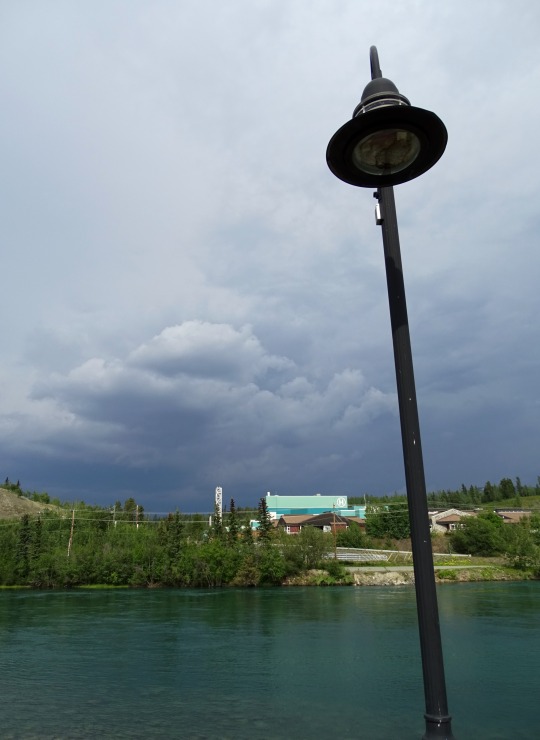
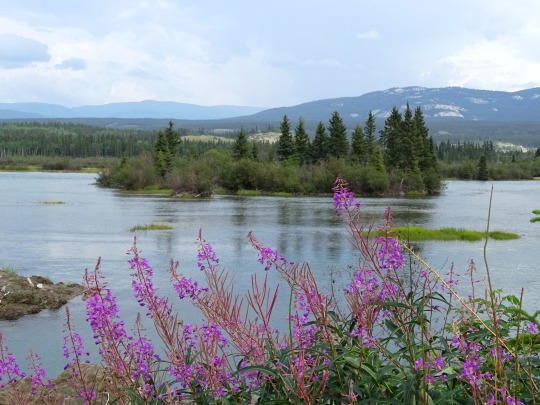
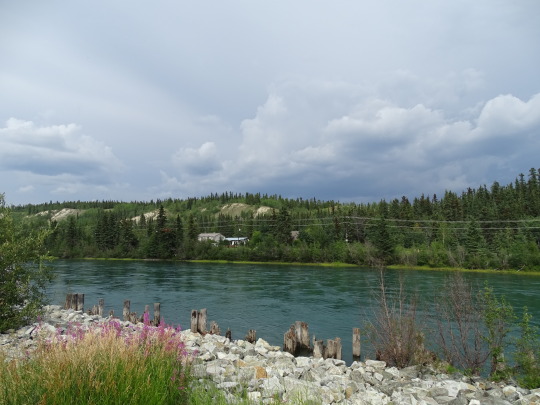
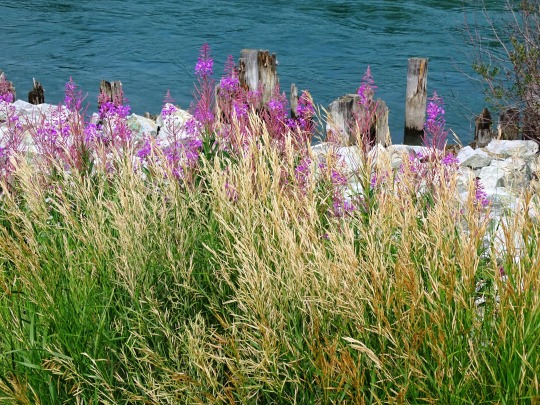

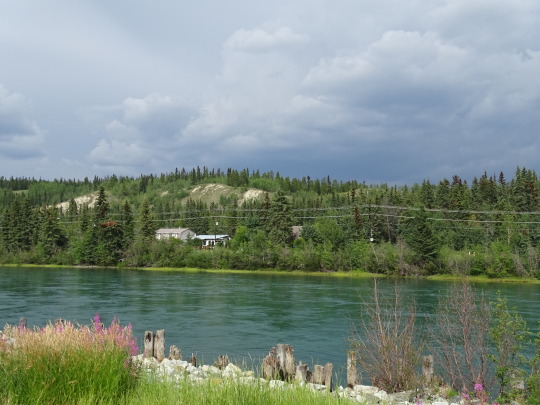
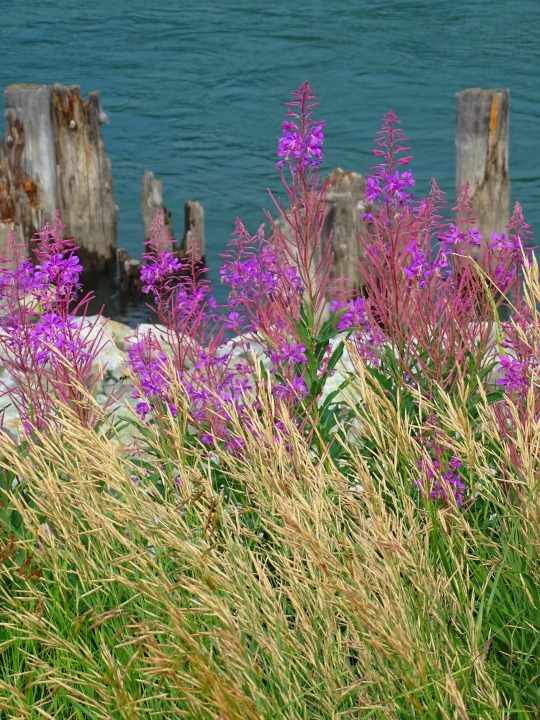
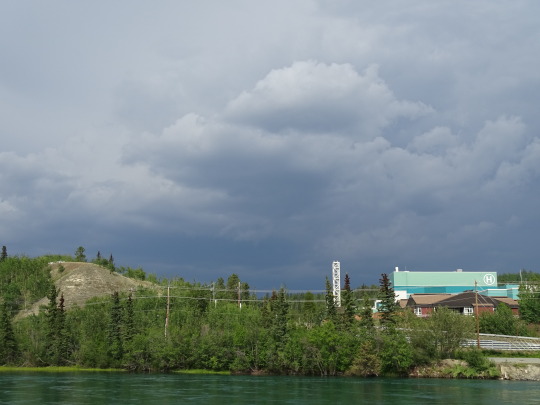


Yukon River, Whitehorse (No. 3)
The generally accepted source of the Yukon River is the Llewellyn Glacier at the southern end of Atlin Lake in British Columbia. Others suggest that the source is Lake Lindeman at the northern end of the Chilkoot Trail. Either way, Atlin Lake flows into Tagish Lake (via the Atlin River), as eventually does Lake Lindeman after flowing into Bennett Lake. Tagish Lake then flows into Marsh Lake (via the Tagish River). The Yukon River proper starts at the northern end of Marsh Lake, just south of Whitehorse. Some argue that the source of the Yukon River should really be Teslin Lake and the Teslin River, which has a larger flow when it reaches the Yukon at Hootalinqua. The upper end of the Yukon River was originally known as the Lewes River until it was established that it actually was the Yukon. North of Whitehorse, the Yukon River widens into Lake Laberge, made famous by Robert W. Service's "The Cremation of Sam McGee". Other large lakes that are part of the Yukon River system include Kusawa Lake (into the Takhini River) and Kluane Lake (into the Kluane and then White River).
The river passes through the communities of Whitehorse, Carmacks, (just before the Five Finger Rapids) and Dawson City in Yukon, and crossing Alaska into Eagle, Circle, Fort Yukon, Stevens Village, Rampart, Tanana, Ruby, Galena, Nulato, Grayling, Holy Cross, Russian Mission, Marshall, Pilot Station, St. Marys (which is accessible from the Yukon at Pitkas Point), and Mountain Village. After Mountain Village, the main Yukon channel frays into many channels, sprawling across the delta. There are a number of communities after the "head of passes," as the channel division is called locally: Nunum Iqua, Alakanuk, Emmonak, and Kotlik. Of those delta communities, Emmonak is the largest with roughly 760 people in the 2000 census. Emmonak's gravel airstrip is the regional hub for flights.
Source: Wikipedia
#Whitehorse#Yukon#travel#original photography#vacation#tourist attraction#landmark#cityscape#landscape#Yukon River#summer 2023#woods#forest#flora#nature#engineering#the North#fireweed#wildflower#river bank#Canada#architecture#sculpture#dark clouds#street lamp#street light
6 notes
·
View notes
Text
Is Fairbanks Alaska Tap Water Safe to Drink in [year]?
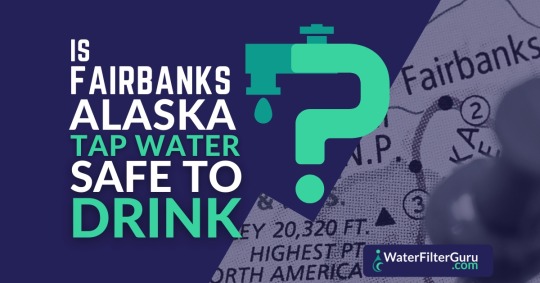
How safe is the tap water in Fairbanks, Alaska? Are there any water contaminants that you should know about, and how does the water quality compare to that of other states and cities? Does the Fairbanks water exceed or violate EPA guidelines?
You'll find all the answers to these questions and more in this Fairbanks water quality & safety guide.
📌 Key Takeaways:
- The drinking water in Fairbanks, Alaska is considered generally safe to drink.
- The Environmental Protection Agency (EPA) sets standards for tap water safety that all water utilities, including Fairbanks, must comply with.
- The 4 biggest problem contaminants in Fairbanks tap water are disinfection byproducts, chromium-6, PFOA, and radium - but these contaminants don't exceed the EPA's Maximum Contaminant Levels.
🚰 Can You Drink Fairbanks Tap Water?
Yes, you can drink the water in Fairbanks, Alaska. The water doesn't violate the Safe Drinking Water Act (SDWA) and is regulated for safety by the Environmental Protection Agency - which technically makes the water safe to drink.
The most recent of Fairbanks' annual Consumer Confidence Reports shows that no contaminants are present in quantities exceeding the EPA's Maximum Contaminant Levels (MCLs), meaning that you shouldn't experience health effects from drinking the City's water.
However, Fairbanks tap water isn't perfect quality, clean, or pure. There are still some contaminants present - even if they're detected below the EPA's maximum allowances.
The Environmental Working Group is an independent organization that contests the EPA's guidelines, arguing that they're too lenient. The EWG has conducted its own research and produced a Tap Water Database for most Cities, including Fairbanks. In this database, 10 contaminants were noted to exceed the EWG's Health Guidelines.
So, the drinking water distributed by the Fairbanks water service is safe according to EPA standards, but the EWG believes otherwise. We've looked more closely at these 10 contaminants later.
There's also a low risk of lead contamination in Alaska. Lead is a highly toxic heavy metal with known health effects, including cancer. The most common way for lead to enter a municipal water supply is through old underground water pipes that were installed before lead became an illegal material to use in service lines. The danger of this type of lead contamination is that 0 PPM of lead might be detected at the water utility, but once water reaches your home, it might have absorbed dangerous levels of lead from its journey through the pipes.
There are several regional programs in place that should reduce your likelihood of lead exposure in Fairbanks, including the Regional Health Corporation Remote Maintenance Worker Programs and Alaska Village Safe Water Program. However, there's still a risk that lead might leach into your water from your own plumbing if you have an old home built before 1986.
You can test your water for lead and fill out a survey to help the local water utility to determine where customer-owned lead service lines exist.
👨🔧 Looking for further reading? Our guide looks in detail at which 10 states have the worst-quality tap water.
Fairbanks SDWA Violations Within 10 Years
Data Source: EPA ECHO database
🗺️ Where Does the Tap Water in Fairbanks Come From?
The majority of Fairbanks tap water comes from three wells beneath the City. These wells tap into a very large aquifer located beneath Tanana Vally and are between 70 to 90 feet deep. The City established its groundwater supply and distribution system in 1953.
The groundwater occurs in varying conditions depending on its exact location. Under the ground of the Tanana valley and under the higher slopes and ridges, groundwater occurs under water-table conditions. On the lower slopes, the water exists in artesian conditions.
Groundwater is generally higher-quality than surface water (such as rivers and reservoirs) because water is naturally filtered as it seeps through the layers of rock and earth into the aquifer. However, there are certain contaminants that specifically affect the quality of groundwater, including iron, manganese, and water hardness. Most groundwater in Fairbanks is naturally high in iron, but some groundwater supplies are iron-free.
Like all community water systems adhering to the EPA's guidelines, the Fairbanks water service conducts hundreds of water tests per year (including testing at the source and post-treatment testing) as part of an ongoing assessment of water quality. If you want to keep informed and monitor the regular test results released in Fairbanks, you can use Alaska's Drinking Water Watch webpage, which lets you search for test results (including an option to search for specific parameters) from an independent laboratory.
Water is then pumped to the Golden Heart Utilities Water Treatment Plant, where it undergoes several treatment processes, including mechanical filtration to remove particles, and (if necessary) UV treatment or chlorination to kill bacteria and other microorganisms.
The treated drinking water is stored in large reservoirs or water pressure tanks, ensuring that customers in Fairbanks have access to a reliable and constant supply of water even during times of peak demand.
Pressurized water is delivered via main water networks, which run under the City's sidewalks and streets. Property owners are connected to the public watermains through their own private service lines.
Source: usgs.gov
📉 Who Regulates Fairbanks Drinking Water?
The City of Fairbanks tap water is managed by the Golden Heart Utilities Water Treatment Plant and is regulated by the Environmental Protection Agency, the Division of Environmental Health Drinking Water Program, and the Alaska Department of Environmental Conservation Division of Water.
All public water utilities must comply with the EPA's National Primary Drinking Water Regulations, regulated drinking water contaminants that are considered (based on studies and research) to be harmful to human health.
According to these Regulations, water utilities - including Fairbanks, Alaska - must reduce contaminants to below the EPA's maximum allowance - and provide water monitoring and testing as proof.
The EPA also has several Health Advisories for emerging contaminants that aren't yet officially regulated. Water utilities aren't legally required to reduce these contaminants but may choose to do so based on the evidence that exists relating to their health effects.
The Division of Environmental Health Drinking Water Program helps ensure that public water systems comply with these EPA regulations and health advisories (and any state regulations) to provide safe drinking water with no risk of disease or exposure to dangerous contaminants.
General water quality standards in Alaska are evaluated by the Quality Standards team at the Alaska Department of Environmental Conservation Division of Water. These standards don't just cover drinking water quality - they're also used to develop waterbody recovery goals, monitoring plans, and more.
🧪 Fairbanks Annual Water Quality Report
The most recent Water Quality Report (or Consumer Confidence Report) for Fairbanks, Alaska is dated from January to December 2021.
The Report shares everything you need to know about the City's water quality, including the water source, results from the 2021 water tests, and how contaminant levels in the water compare to the EPA's MCLs.
According to the Report, no contaminants in the City's drinking tap water violate the EPA's health guidelines, meaning that it's technically safe to drink water in Fairbanks. However, this doesn't guarantee that Fairbanks drinking water is completely clean or pure.
For example, the Report documents that 0.41 pCi/L of radium was detected in the City's water. That's still well below the EPA's MCL of 5 pCi/L, but most folks would probably rather not drink even trace amounts of this radioactive metal in their water.
All of the contaminants listed in the Report were detected below EPA MCLs, including:
- Iron
- Radium
- Arsenic
- Fluoride
- Barium
- Haloacetic acids
- Free chlorine
- Manganese
Many contaminants haven't been included in this Report, which tells us that they're not detected in the water and therefore don't need to be documented or compared to EPA regulations.
Keep in mind that the data in annual Consumer Confidence Reports is only accurate for the specific testing period. The EPA continues to reevaluate its standards and regulations based on emerging evidence on the dangers and health effects of certain contaminants. Some contaminants currently aren't regulated by the EPA, such as emerging contaminants like PFAS.
We recommend reading through the Consumer Confidence Report and noting any contaminants that you want to research or learn more about. You can also compare this most recent Report to previous annual Reports (available on the Golden Heart Utilities website) to get an idea of how the quality of the City's water has changed over the years.
☣️ Contaminants Found Above Guidelines in Tap Water in Fairbanks
None of the contaminants in Fairbanks drinking water exceed the EPA guidelines. So, here, we've focused on the contaminants present in levels that exceed the EWG's Health Guidelines.
To quickly refresh, the EWG is an independent organization and its guidelines are simply that: guidelines.
However, many folks agree with the EWG that the EPA allows unacceptable levels of contaminants in drinking water. If you're in this boat, you'll want to know which contaminants in Fairbanks water exceed the stricter Guidelines set by the EWG:
Hexavalent Chromium
Hexavalent chromium, or chromium-6, has serious health effects if consumed in high doses in contaminated water. This cancer-causing chemical usually gets into water as a result of industrial pollution and can't be removed with a standard water filter. 0.0525 PPB (parts per billion) of hexavalent chromium was found in Fairbanks drinking tap water - 2.6x the EWG's Health Guideline of 0.02 PPB for this drinking water contaminant. Hexavalent chromium currently isn't regulated by the EPA.
Haloacetic acids (HAA5)† and Haloacetic acids (HAA9)†
Chlorine disinfection produces two types of haloacetic acids: HAA5 and HAA9. These disinfection byproducts increase the risk of various cancers, including bladder and liver cancer. Fairbanks has HAA5 and HAA9 contaminated water - 25.2 PPB of HAA5 and 21.3 PPB of HAA9 were detected. That's between 252 and 355x over the EWG's Health Advisories of 0.1 PPB and 0.06 PPB. The EPA has set a legal limit of 60 PPB for HAA5, and there's currently no legal limit for HAA9.
Perfluorooctanoic acid (PFOA)
Perfluorooctanoic acid, or PFOA for short, is a chemical belonging in the group of "forever chemicals" called PFAS chemicals, used in fire fighting foams, non-stick cookware, and more. PFOA can remain in the human body for long periods of time and may affect growth, development, and reproduction. 1.07 PPT (parts per trillion) of PFOA was detected in Fairbanks municipal water - 152x the EWG's recommended Health Guideline of 0.007 PPT. The EPA currently doesn't regulate PFOA.
Radium (-226 & -228)
Radium -226 & -228 were also detected in Fairbanks tap water. Radium is one of the radiological contaminants with known health effects if consumed over long periods, including anemia, cancer, and depression of the immune system. The EWG recorded 0.41 pCi/L (picoCurie per liter) of radium in Fairbanks water - 8.2x the EWG's recommended Health Guideline of 0.05 pCi/L. The EPA has set a legal limit of 5 pCi/L for this contaminant.
Total trihalomethanes (TTHMs)†
Another potentially cancer-causing drinking water contaminant caused by chlorine disinfection is trihalomethanes (TTHMs). 39.1 PPB of this disinfection byproduct was detected in Fairbanks drinking water, which is 261x the EWG's recommended Health Guideline of 0.15 PPB. However, this doesn't exceed the EPA enforcement of 80 PPB for this contaminant.
Other Disinfection Byproducts
Several other disinfection byproducts, including bromodichloromethane, chloroform, dichloroacetic acid, and trichloroacetic acid were also detected above the EWG's Health Guidelines in Fairbanks drinking water. Between 3.13 PPB and 36.0 PPB of these impurities were detected - that's between 51x and 150x the EWG's Health Guidelines. None of these impurities are legally regulated by the EPA.
The most abundantly present contaminants in Fairbanks drinking water are disinfection byproducts. What's worrying is that many of these, including dichloroacetic acid, trichloroacetic acid, and HAA9, aren't currently regulated by the EPA. This is one of the reasons why they're so commonly found in public drinking water supplies: they aren't legally required to be reduced or maintained within certain levels.
Emerging research suggests that disinfection byproducts may cause a number of health problems, like liver damage and cancer, as well as decreased nervous system activity.
How can you prevent contamination from disinfection byproducts? You can't, really - they're produced as a result of disinfecting water with chemicals. However, some disinfectants, such as chloramine, are less reactive with organic matter in water, and produce fewer byproducts.
You could petition for better use of disinfectants, or (the quicker and easier option) you could install a water filter in your home to remove these contaminants.
🧫 Main Contaminants Found in Fairbanks Tap Water
We know which drinking water impurities are present in potentially dangerous levels in Fairbanks tap water.
But what about the other contaminants? There are a few additional impurities that the EPA and the EWG deem to be present in acceptable amounts:
- 1,1-Dichloroethane - A colorless oily liquid (classed as a volatile organic compound) used to produce various chemicals and as a solvent in some varnish and paint removers; may have heart and kidney effects if prolonged exposure to high concentrations occur.
- Disinfection byproducts like chlorate, dibromochloromethane, monobromoacetic acid, and monochloroacetic acid; produced when chlorine and other disinfectants react with naturally occurring organic matter in water; may cause liver damage and increased risk of cancer.
- Manganese - A mineral that occurs in rocks and soils and enters groundwater as it seeps into the aquifer; doesn't have any health risks in naturally occurring levels but is a known water hardness mineral that causes scale in plumbing and other hard water effects.
- Several types of PFAS, including perfluorohexane sulfonate (PFHXS), perfluorohexanoic acid (PFHxA), and perfluorooctane sulfonate (PFOS); persistent, toxic, and bioaccumulating chemicals that are used in numerous manufacturing processes and have been linked to cancer, developmental issues, immune system disruption, liver damage, and more.
- Strontium - A silvery heavy metal that's found naturally in calcium carbonate and other minerals; may cause cancer in large doses but shouldn't cause harmful effects in low levels.
- Total chromium - Refers to both chromium-3 (harmless) and chromium-6 (dangerous; linked to kidney and liver damage and cancer if consumed in high levels) which are often found together in water.
- Vanadium - A metal that's naturally released into water through rock and soil erosion and fossil fuel deposits; doesn't pose a health risk when it occurs in low levels in drinking water.
⛲ Fairbanks Drinking Water in Public Places
We know what to expect from the water we drink at home in Fairbanks - but what about when you're out and about? How does Fairbanks tap water compare to the City's public water in hotels, bars, and restaurants?
In restaurants and bars in the City, you should legally be given free tap water (the same that comes out of your taps at home) if you ask for it. Some restaurants may filter their tap water and offer it to you for free.
The same goes for hotels - if you ask at the reception or bar for clean tap water, it should be provided to you. Most hotels in Fairbanks have clean drinking water in their rooms, but if you're not sure, check with staff at the reception desk.
If you'd rather avoid drinking the public water in Fairbanks, you can buy bottled water from most stores. You'll find popular brands like Smartwater, Dasani, and Aquafina, across the City. Make sure to recycle your water bottles to avoid plastic waste.
💬 Frequently Asked Questions
Can I drink the tap water in Fairbanks?
Yes, you can drink the tap water in Fairbanks. Like the majority of Cities in the US, Fairbanks is legally obligated to treat its tap water to make it potable and safe to drink according to standards set by the EPA. That means all property owners in the City can safely drink the tap water without health effects - but there are still trace levels of certain contaminants in Fairbanks water.
How clean is Fairbanks water?
Fairbanks water isn't exceptionally clean or pure, but it's still clean enough to drink. There are trace contaminants like PFOA and disinfection byproducts in Fairbanks tap water, but these contaminants are only present in low levels and shouldn't have any health effects. However, some Fairbanks residents choose to filter their water to remove these contaminants and enjoy cleaner, safer, tastier water.
Does Fairbanks water have chlorine?
Yes, Fairbanks water has chlorine. The City's water supply is disinfected with chlorine or similar chemicals to kill microorganisms and prevent waterborne diseases. You might notice a chemical, swimming pool-like taste or smell in water from your faucet. A good water filter, such as an activated carbon filter, can be used to remove chlorine in the water in your home.
Is Fairbanks water fluoridated?
Fairbanks water used to be fluoridated as part of the national community water fluoridation effort, established to reduce dental costs associated with cavities, tooth decay, and other dental health issues. Fluoride has been proven to support dental health but may have negative health effects when consumed in excess. However, additional fluoride is no longer added to Fairbanks drinking tap water after the Fairbanks City Council voted 5-1 in 2011 against fluoridation of its water supply. This is because Fairbanks water naturally contains around 0.3 parts per million, so adding artificially created fluoride was deemed unnecessary and potentially unsafe.
Read the full article
0 notes
Text

In the teens, someone who was incredibly stupid was known as being “as cunning as a dead pig.” An excellent example is this Alaska Railroad bridge over the Tanana River during the Alaska Gold Rush. Constructed of wood, it could not withstand the river icebergs and ‘vanished’ the first winter after it was constructed. Thereafter, the bridges for the Alaska Railroad were made of concrete and steel.
[From THE HUMAN FACE OF THE ALASKA GOLD RUSH.]
👉Learn more: https://authormasterminds.com/details/3DwEy
👉Watch the short video: https://youtu.be/mocJb-YivXU
SteveLevibooks #readersandwritersbookclub #authormasterminds #thrillers #Mysteries #crimebooks
0 notes
Text
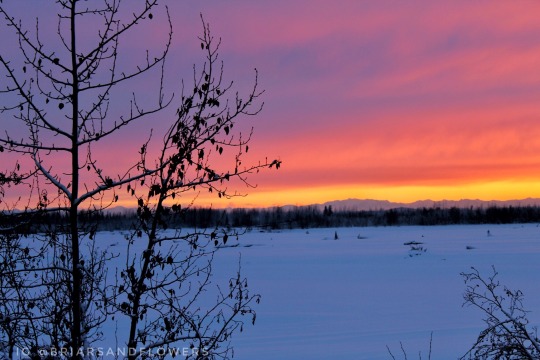

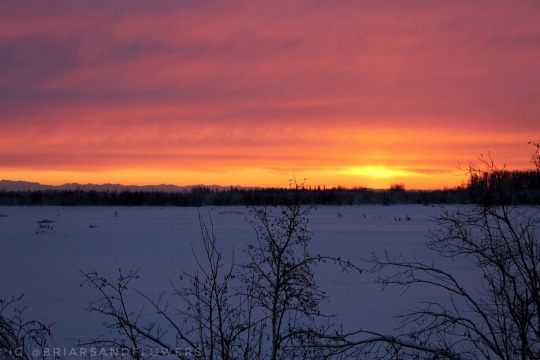
Amazing how even the rushing Tanana River manages to freeze over for our long, dark winters.
#my phoyography#photography#alaska#tanana#tanana river#nature#nature photography#sunset#winter#frozrn river#we have 4 hours of daylight#last frontier
10 notes
·
View notes